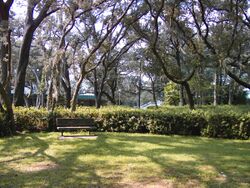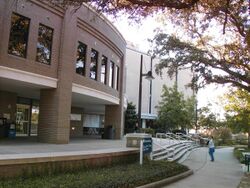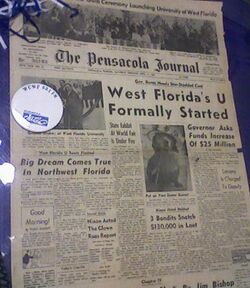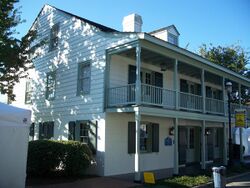University of West Florida
Topic: Organization
 From HandWiki - Reading time: 8 min
From HandWiki - Reading time: 8 min
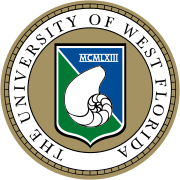 | |
| Motto | "No Limit" |
|---|---|
| Type | Public university |
| Established | 1963 |
Parent institution | State University System of Florida |
Academic affiliations | Space-grant |
| Endowment | $74.6 million (2020)[1] |
| President | Martha Dunagin Saunders |
Academic staff | 374 |
| Students | 13,043[2] |
| Undergraduates | 9,619[2] |
| Postgraduates | 3,424[2] |
| Location | Pensacola , Florida , United States [ ⚑ ] : 30°32′58″N 87°13′05″W / 30.5495°N 87.2181°W |
| Campus | Small city[3] |
| Other campuses |
|
| Newspaper | The Voyager |
| |u}}rs | Blue and green[4] |
| Nickname |
|
Sporting affiliations | NCAA Division II – Gulf South |
| Mascot | Argie the Argonaut[5] |
| Website | www |
 | |
The University of West Florida (West Florida or UWF) is a public university in Pensacola, Florida, United States . Established in 1963 as a member institution of the State University System of Florida, the University of West Florida is a comprehensive research university without faculties of law or medicine, a designated space-grant institution, and sits on the third largest campus in the State University System, at 1,600 acres (650 ha). The university's mascot is Argie the Argonaut and its logo is the chambered nautilus.[6]
History
In 1962, the Florida Legislature authorized the State Board of Education to locate a state university in Escambia County. Harold Crosby was appointed the first president in July 1964. UWF became the sixth institution of the State University System of Florida, which today consists of twelve public universities.[7]
Ground was broken on April 16, 1965, and in the same year the chambered nautilus was adopted as the official UWF emblem. UWF was originally an upper-level institution, enrolling juniors, seniors and graduate students. The first students began classes in the fall of 1967, and in June 1968, 58 students received degrees in the first commencement ceremony.[8] In 1969, the Southern Association of Colleges and Schools accredited the university undergraduate programs, and the first master's degree programs were established.
In July 1979, the university organized into a more traditional structure by establishing three colleges: Arts and Sciences, Business, and Education. In 1999, the colleges reorganized into the College of Arts and Sciences, the College of Business and the College of Professional Studies. In Aug. 2012, the former three-college structure transitioned into four academic colleges: College of Arts, Social Sciences and Humanities; College of Education and Professional Studies; College of Science, Engineering and Health; and the College of Business. The most recent reorganization took place in 2015, splitting the former College of Science, Engineering and Health in two.
Today, the university has four colleges: College of Arts, Social Sciences and Humanities; College of Business; Hal Marcus College of Science and Engineering; and Usha Kundu, MD College of Health. In addition, UWF has the School of Education.[9]
Chambered Nautilus
Harold Crosby, the university's first president, selected the chambered nautilus to represent UWF because he was inspired by the poem "The Chambered Nautilus" by Oliver Wendell Holmes; it is "a symbol of growth, change and accomplishment."[8]
Administration, academics and organization
| University rankings | |
|---|---|
| National | |
| Forbes[11] | 442[10] |
| THE/WSJ[12] | 600 |
| Regional | |
| U.S. News & World Report[13] | 26 |
| Master's University class | |
| Washington Monthly[14] | 103 |
|
2022-2023 USNWR Best Regional Colleges South Rankings[15] | |
|---|---|
| Regional Universities South | 26 |
| Top Public Schools | 10 |
| Top Performers on Social Mobility | 54 |
| Best Value School | 54 |
| Best Undergraduate Engineering | 130 |
| Nursing | 206 |
| Best colleges for Veterans (tie) | 9 |
The University of West Florida is a public institution, receiving most of its funding through state funds and tuition. A 13-member Board of Trustees governs the university. The board is composed of six members appointed by the Governor of Florida, five appointed by the Board of Governors, the Faculty Senate president and the president of the Student Government Association.[16]
The undergraduate and graduate programs are divided into four colleges: College of Arts, Social Sciences and Humanities; College of Business; Hal Marcus College of Science and Engineering; and Usha Kundu, MD College of Health.
The University of West Florida is composed of four divisions which manage the operations of the institution as well as its direct support organizations: Academic Affairs; Academic Engagement and Student Affairs; Finance and Administration; and University Advancement.[17]
Campuses
Pensacola campus
The main campus of 1,600 acres (6.5 km2) of rolling hills and natural woodland along the Escambia River is ten miles (16 km) north of downtown Pensacola, in the Ferry Pass area.[18] Its facilities have been designed to complement the natural forest and waterways. UWF's John C. Pace Library is the largest library in the Northwest Florida area. In addition to the main library on the main campus north of Pensacola, Florida, there is a branch library in Fort Walton Beach, Florida. It has 628,000 printed volumes, 1 million microfilms and microfiches, 3,000 serial subscriptions and nearly 2,000 online journal subscriptions.[19] UWF has a second location, UWF on the Emerald Coast, in Fort Walton Beach, Florida.
Historic Pensacola Village
In 2001, the university acquired West Florida Historic Preservation, Inc, the previously state-controlled group that manages the Historic Pensacola Village. The university has created several classes taught by and/or in conjunction with the staff at Historic Pensacola.
UWF Historic Trust
The UWF Historic Trust collects, preserves and interprets the history of northwest Florida.[20]
Arcadia Mill Complex
The Arcadia Mill complex is on the National Register of Historic Places. It was the first industrial complex powered by water in Florida. It included shops, mills, a railroad drawn by mules and a 16-mile log flume.[21] It operated from 1817 to 1855. It is curated by the University of West Florida.
Student life
| Race and ethnicity[22] | Total | ||
|---|---|---|---|
| White | 65% | ||
| Black | 11% | ||
| Hispanic | 10% | ||
| Other[lower-alpha 1] | 8% | ||
| Asian | 4% | ||
| Foreign national | 2% | ||
| Economic diversity | |||
| Low-income[lower-alpha 2] | 32% | ||
| Affluent[lower-alpha 3] | 68% | ||
Currently, UWF enrolls more than 12,500 students between undergraduate and graduate programs across its colleges.[23] UWF has conferred more than 100,000 associate, bachelor's, master's, specialist and doctoral degrees.[24]
UWF hosts many opportunities for involvement through student clubs and organizations. Registered student organizations, administered by Student Involvement, include academic clubs, Greek organizations, professional and honor societies, religious organizations and special interest groups.[25] Additionally, UWF owns property on Pensacola Beach, frequently used by students for research and recreation. UWF also offers numerous on-campus mountain bike trails[26] to students free of charge, in addition to a wide variety of recreational activities.
Housing
UWF offers traditional residence halls, small community residence halls and university-owned apartment complexes. The university also offers living learning communities, which provide signature programming and academic support to residents.[27]
Greek life
There are numerous fraternities on campus.
Transportation
UWF offers a trolley service and public bicycles around campus known as "yellow bikes". There is parking for all visitors, students and employees. The Escambia County Area Transit bus system also offers students a discount rate.
Athletics
West Florida athletic teams are the Argonauts. The university is a member of the Division II level of the National Collegiate Athletic Association (NCAA), primarily competing in the Gulf South Conference (GSC) since the 1994–95 academic year. The Argonauts previously competed in the Southern States Conference of the National Association of Intercollegiate Athletics (NAIA) from 1974–75 to 1993–94, with a brief hiatus of dropping its athletics program from 1976–77 to 1979–80.
West Florida competes in 15 intercollegiate varsity sports: Men's sports include baseball, basketball, cross country, football, golf, soccer and tennis; while women's sports include basketball, cross country, golf, soccer, softball, swimming and diving, tennis and volleyball.[28]
Accomplishments
UWF's athletic program has won ten national championships, with the most recent being football in the 2019 NCAA Division II Football Championship;[29] as well as winning a women's tennis GSC championship for the 19th time, making that its 100th conference championship in school history.[30]
Football
In 2015, the university welcomed its first football team on campus and held intra-team scrimmages throughout the fall. In 2016, UWF hosted its inaugural season, kicking off with a 45–0 win against Ave Maria University.[31]
In 2017, the football program qualified for the NCAA Division II playoffs in just its second season. The team reached the championship game, losing to Texas A&M-Commerce, 37–27, in just the 26th game in school history.[32]
In 2019, UWF's football program won the NCAA Division II national championship in its fourth season, winning against Minnesota State University, 48–40.[33]
Notable people
Image gallery
See also
- John C. Pace Library
Notes
References
- ↑ As of June 30, 2020. U.S. and Canadian Institutions Listed by Fiscal Year 2020 Endowment Market Value and Change in Endowment Market Value from FY19 to FY20 (Report). National Association of College and University Business Officers and TIAA. February 19, 2021. https://www.nacubo.org/-/media/Documents/Research/2020-NTSE-Public-Tables--Endowment-Market-Values--FINAL-FEBRUARY-19-2021.ashx. Retrieved February 21, 2021.
- ↑ 2.0 2.1 2.2 "Facts and Figures". https://uwf.edu/about/facts-and-figures/.
- ↑ "IPEDS-University of West Florida". https://nces.ed.gov/collegenavigator/?q=Florida&s=all&pg=6&id=138354.
- ↑ "Color | University of West Florida". https://uwf.edu/brand/color/.
- ↑ "Argie the Argonaut". https://goargos.com/sports/2014/11/14/GEN_1114145614.aspx.
- ↑ Midge Lipkin (2009). The College Sourcebook for Students with Learning & Developmental Differences. Wintergreen Orchard House. p. 259. ISBN 9781936035014. https://books.google.com/books?id=ZFprnj39Fs4C&pg=PA259.
- ↑ "History | University of West Florida". https://uwf.edu/about/at-a-glance/history/.
- ↑ 8.0 8.1 "Traditions | University of West Florida". https://uwf.edu/offices/presidents-office/presidential-inauguration/traditions/.
- ↑ "Academics | University of West Florida". https://uwf.edu/academics/.
- ↑ "University of West Florida Ranking". https://www.forbes.com/colleges/the-university-of-west-florida/?sh=1eed67f57352.
- ↑ "America's Top Colleges 2019". Forbes. https://www.forbes.com/top-colleges/list/.
- ↑ "U.S. College Rankings 2020". Wall Street Journal/Times Higher Education. https://www.timeshighereducation.com/rankings/united-states/2020#!/page/0/length/25/sort_by/rank/sort_order/asc/cols/stats.
- ↑ "Best Colleges 2021: Regional Universities Rankings". U.S. News & World Report. https://www.usnews.com/best-colleges/rankings/regional-universities.
- ↑ "2020 Rankings -- Masters Universities". Washington Monthly. https://washingtonmonthly.com/2020college-guide/masters.
- ↑ "University of West Florida Rankings". U.S. News & World Report. https://www.usnews.com/best-colleges/university-of-west-florida-3955/overall-rankings. Retrieved September 25, 2022.
- ↑ "Board of Trustees | University of West Florida". https://uwf.edu/offices/board-of-trustees/.
- ↑ "Divisions | University of West Florida". https://uwf.edu/about/divisions/.
- ↑ "The University of West Florida" (in en). http://map.uwf.edu/?id=1250.
- ↑ "Office of the Dean of Libraries: Statistical Reports". https://libguides.uwf.edu/c.php?g=215171&p=1420662.
- ↑ "Historic Trust". https://uwf.edu/university-advancement/departments/historic-trust/.
- ↑ "Arcadia Mill Complex". https://uwf.edu/cassh/departments/anthropology-and-archaeology/research/faculty-and-staff-projects/industrial/arcadia-mill-complex/.
- ↑ "College Scorecard: University of West Florida". United States Department of Education. https://collegescorecard.ed.gov/school/?138354-The-University-of-West-Florida.
- ↑ "UWF reaches record enrollment of more than 13,000 students for Fall 2016 semester" (in en-US). 2016-08-24. https://news.uwf.edu/uwf-reaches-record-enrollment-of-more-than-13000-students-for-fall-2016-semester/.
- ↑ "Facts & Figures | University of West Florida". https://uwf.edu/about/at-a-glance/facts-and-figures/.
- ↑ "Student Involvement | University of West Florida". https://uwf.edu/academic-engagement-and-student-affairs/departments/student-involvement/.
- ↑ "UWF Trail Maps | University of West Florida". https://uwf.edu/academic-engagement-and-student-affairs/departments/recreation/facilities/uwf-trail-maps/.
- ↑ "Living Learning Communities | University of West Florida". https://uwf.edu/academic-engagement-and-student-affairs/departments/housing-and-residence-life/living-learning-communities/.
- ↑ "University of West Florida Argonauts - University of West Florida". http://goargos.com/.
- ↑ "West Fla. vs Minn. St. Mankato DII Football Game Summary - December 21st, 2019 | NCAA.com" (in en). https://www.ncaa.com/game/3909055.
- ↑ "UWF Their 19th GSC Championship and the 100th Conference Championship in UWF History". http://www.goargos.com/news/2019/5/4/west-florida-womens-tennis-wins-their-19th-gsc-championship-and-the-100th-conference-championship-in-uwf-history.aspx.
- ↑ Vilona, Bill. "UWF football is 'phenomenal' in inaugural 45-0 win" (in en-US). https://www.pnj.com/story/sports/2016/09/03/uwf-opener-rain-delay-estimated-restart-scheduled/89839298/.
- ↑ "West Florida Loses to Texas A&M Commerce in National Championship" (in en-US). 2017-12-16. https://www.wkrg.com/news/west-florida-loses-to-texas-am-commerce-in-national-championship/.
- ↑ "UWF football wins national championship with historic offensive explosion". Pensacola News Journal. https://www.pnj.com/story/news/2019/12/21/uwf-football-wins-national-championship-over-minnesota-state/2721427001/.
External links
 |
 KSF
KSF